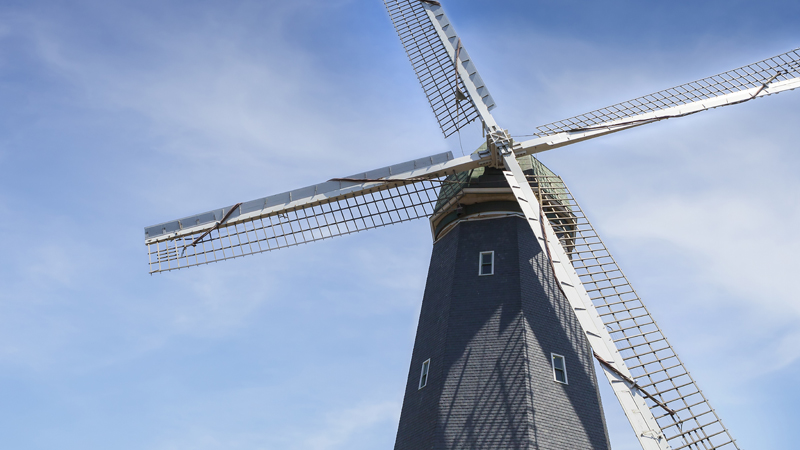
When Golden Gate Park was conceptualized, there was not enough groundwater to turn the Sunset District sand dunes into lush green parkland, let alone to fill several man-made lakes. To secure the water needed, a plan was made to harness the coastal winds to pump deep water closer to the ocean shore. The result was the construction of two giant windmills, the Dutch Windmill and the Murphy Windmill, that would pump fresh well water from depths of 200 feet for the park.
The Dutch Windmill, also called the North Windmill, was completed in 1902. It was such a huge success that the mayor encouraged the building of a second windmill to supplement the first.
Construction of the second Golden Gate Park windmill, the Murphy Windmill, began in 1905 and was completed in 1907 after encountering delays caused by the great 1906 earthquake. Also called the South Windmill, this giant windmill and the adjacent Millwright’s Cottage were funded by the donation of $20,000 from Samuel Murphy, vice president of San Francisco’s Hibernia Bank as a gift to the city. The dome was made from donated copper, while a local lumber company contributed the timber.
The windmill design, by a Bay Area engineer named J. C. H. Stut, incorporated mechanical elements of both Dutch and European influence, along with his own unique western touches. Capable of drawing 40,000 gallons of water per hour on a windy day, the Murphy Windmill is the largest of its kind in the world, boasting 114 foot long sails, each cut from a single log.
Standing in excess of 95 feet tall, the Murphy Windmill pumped water from the West Basin Aquifer, located approximately 200 feet below the park’s surface. The original location of the well is unknown, however, a pump in the well house brought water into a storage pond just west of the windmill. It is estimated that the windmill ran up to twelve hours a day, pulling water from the pond and pumping it up to Strawberry Hill.
The reservoir at Strawberry Hill provided the irrigation water source for the entire park east of 19th Avenue. The water that wasn’t used for the east half of the park overflowed down Huntington Falls into Stow Lake, which provided irrigation water west of 19th Avenue. The park’s irrigation system at the time was pressurized by gravity alone.
Together the two Golden Gate Park windmills have become known as the San Francisco Giants, pumping 70,000 gallons of water per hour into the park.
Around 1913, both windmills received electric pumps, making their rotating sails irrelevant. They were decommissioned in 1935 after modern irrigation systems were installed in the park and encountered years of neglect, eventually falling into a state of ruin.
Murphy Windmill Restoration
In 1947, the first restoration project included minor repairs to the windmill and replacement of the sail stocks. The 114-foot spars, made out of six tons of laminated wood, were shipped from Portland, Oregon to replace the deteriorated windmill blades. According to an article written by Krista Hauser, “…the spars were so large that it took up three railroad cars and entangled traffic all afternoon.”
Since the 1947 restoration, there have been several attempts to rehabilitate the Murphy Windmill. In the late 1960’s Eleanor Rossi Crabtree, daughter to former San Francisco mayor Angelo Rossi, campaigned to restore both windmills and bring them back to their former glory.
In 2002, the Recreation and Parks Department began a three-phase construction project that involved cataloging every piece of the mill, dismantling the wood and iron elements, salvaging pieces that could be reused, and restoration of the cap structure. The cap elements were transported to Holland by ship and reconditioned by the Dutch millwright Lucas Verbij. It took several years to restore the 64-ton copper dome.
The second phase involved rehabilitating the concrete base and the slate-clad tower, as well as installing the cap, sails, and gears. The third and final phase includes a water pumping system and landscape improvements.
Know Before You Go
- The Murphy Windmill, also known as the South Windmill, is located in Golden Gate Park, San Francisco, CA 94121.
- Unlike traditional windmills made in the Netherlands, this windmill’s sails turn in a clockwise motion, instead of the typical counterclockwise motion.
- The South Windmill and the adjacent Millwright’s Cottage, built in 1909, were added as a San Francisco Designated Landmark in July 2000.
- Fun Fact: In 1921, the daredevil Velma Tilden climbed aboard the mighty sails and held on for 25 full rotations for a prize of $25 worth of chocolates.






